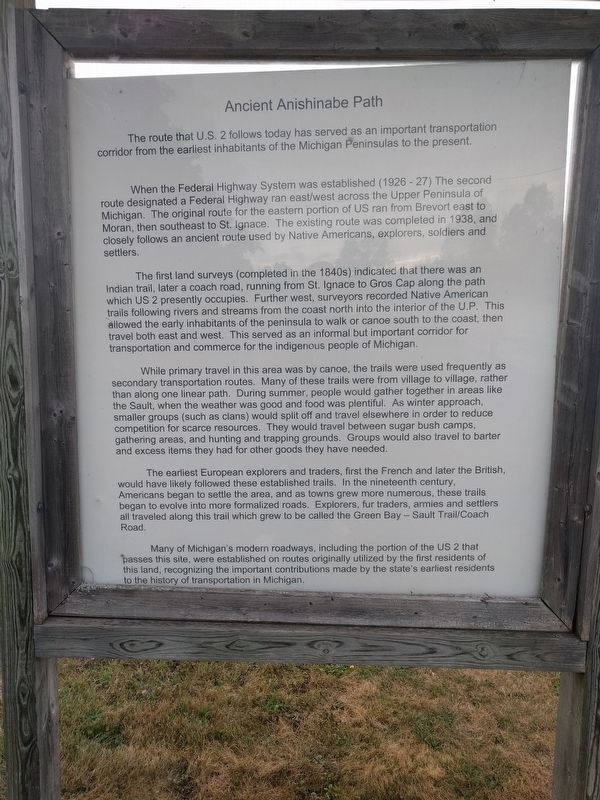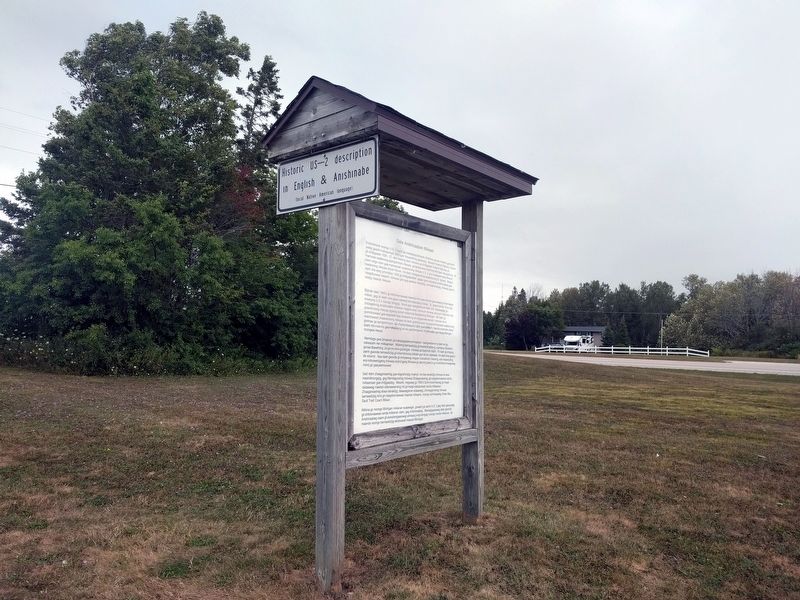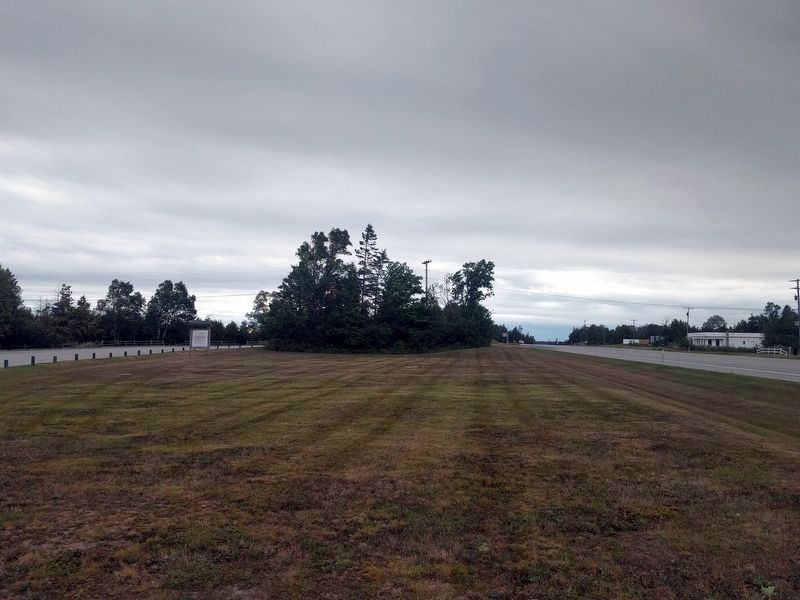Near St. Ignace in Mackinac County, Michigan — The American Midwest (Great Lakes)
Ancient Anishinabe Path / Gete Anishinaabek Miikaan
Inscription.
Ancient Anishinabe Path
The route that U.S. 2 follows today has served as an important transportation corridor from the earliest inhabitants of the Michigan Peninsulas to the present.
When the Federal Highway System was established (1926 - 27) The second route designated a Federal Highway ran east/west across the Upper Peninsula of Michigan. The original route for the eastern portion of US ran from Brevort east to Moran, then southeast to St. Ignace. The existing route was completed in 1938, and closely follows an ancient route used by Native Americans, explorers, soldiers and settlers.
The first land surveys (completed in the 1840s) indicated that there was an Indian trail, later a coach road, running from St. Ignace to Gros Cap along the path which US 2 presently occupies. Further west, surveyors recorded Native American trails following rivers and streams from the coast north into the interior of the U.P. This allowed the early inhabitants of the peninsula to walk or canoe south to the coast, then travel both east and west. This served as an informal but important corridor for transportation and commerce for the indigenous people of Michigan.
While primary travel in this area was by canoe, the trails were used frequently as secondary transportation routes. Many of these trails were from village to village, rather than along one linear path. During summer, people would gather together in areas like the Sault, when the weather was good and food was plentiful. As winter approach, smaller groups (such as clans) would split off and travel elsewhere in order to reduce competition for scarce resources. They would travel between sugar bush camps, gathering areas, and hunting and trapping grounds. Groups would also travel to barter and excess items they had for other goods they have needed.
The earliest European explorers and traders, first the French and later the British, would have likely followed these established trails. In the nineteenth century, Americans began to settle the area, and as towns grew more numerous, these trails began to evolve into more formalized roads. Explorers, fur traders, armies and settlers all traveled along this trail which grew to be called the Green Bay - Sault Trail/Coach Road.
Many of Michigan's modern roadways, including the portion of US 2 that passes this site, were established on routes originally utilized by the first residents of this land, recognizing the important contributions made by the state's earliest residents to the history of transportation in Michigan.
Gete Anishinaabek Miikaan
Enininamook noongo US-2 aapiji giji-naabijikaazisikaade dibishkoo gonaa mewzhi gaantami-yaajig
gaazhi-nakaaziwad, Michigan Neyaashiing gaadaajig. Mewzhi Federal Highway System gii-zhitjigaade 1926 - 27, eko-niishing dash miinwaa gii-zhitjigaade Federal Highway gii-mamowa waabinong-epingishimok nikeyaa, gii-takamoowa shpiming Michigan Neyaashiing. Wi dash wiigo ntam gaa-mamoowak waabanoong nikeyaa U.S. 2 gii-ji-maajitaamoowa Brevort waabinong nikeyaa biinish Moran, mii-dash zhaawanoong-waabanoong St. Ignace. Megwa dash zhe eteg gchimiikan 1938 gii-zhitigaadeban, gegaa gwa naasaap Anishinaabeg gaa-naagidoowad mewzhi, miinwaa gwa geg gaabaa dabagiijig, zhimaaganishag, miinwaa gaa-bi-daajig maanpii nikeyaa.
Bijiinak dash 1840’s gii-dibishaanaawaa maanda kiins gaa-kidwad gaa-aawang Anishinaabe miikan, geg pii dash nwa gaani-aawang bemdaabiijeng miikan, St. Ignace biinish Gros Cap shweying U.S 2 noongo temgag. Noonj gwa epingishmook dash zhe, edaabagiijig gii-zhibiigebiniig Anishinaabe miikanan naagidoowad ziibiinsan miinwaa gwa gchi-ziibiinsan zhe giiwedinoong nikeyaa jiigabiig biinish shipiming Neyaashiing Michigan. Mii dash gii-gishkitoowaad gaa-dagwashnajig neyaashiing wii-zhigaadewosewad, miinwaa wii-ni-makizhewad zhaawanoong nikeyaa mii dash giishkitoowad wii dagwashinoowad waabanoong ginimaa ge epingishimook. Gii-chipiitendaagwod dash gwa eshkam maanda enamook miikan saam mii-maanda gaa-nakaazang wii-wa aashitoogewad Anishinaabe gaa-daajig Michigan noongwa
nikeyaa.
Memdage gwa jiimaanan gii-nakazigaadenoonmaanpii, naangwodanoong dash wii go nakaazam nen miikaansan. Niibining bemaadizijig gii-tkweshkidadiwag odenaang dibishkoo gonaa Bawehting, pii gii-mi-mino-giizhigak, miinwaa gii-baatiinak miijim. Pii dash gii-b’boong aanin gwonda bemaadizijig gii-bikenidoowag pakaan goji wii-wa daawaad, mii-dash kina goya ji-de wiisinid. Naa dash gwonda gii-mi-yaawag megwe ziisbaakidoo-kaaning, enji-maawnjiding, enji-ndoowenjigeng miinwaa enjinii’igeng Miinwaa go aanind gwonda gii-meshkidoonmaagewag noonj go gaayaamoowad.
Geg ntam zhaaganaashag gaa-dagoshinajig maanpii, be-baa-danakiijig miinwaa be-baa-meshidtoongejig, geg Memtagooshag miinwaa Zhaaganaashag gii-naagidoonaawaa nanda miikaasnan gaa-zhitjigaadeg. Mewzhi, megwaaj go 1900’s Gchi-mookmaanag gii-maaji-dadaawag maanpii odenaawensing mii gii-maaji-nakaaziwad nanda miikaansan. Zhaaganaashag ebaa-danakiijig, daawaaganan edaawejig, zhimaaganishag miinwaa bemaadizijig kina gii-naagidoonaawaa maanda miikaans, noongo ezhinikaadeg Green Bay - Sault Trail/ Coach Miikan.
Niibina go noongo Michigan miikanan eyaawogin, gowach go aanin U.S. 2 geg ntam gaa-yaajig gii-zhitoonaawaa nanda miikanan ntam, geg Annishinaabeg. Manaajigaasiwag dash gwonda Anishinaabeg saam gii-kendamigaasiwag wiinwaa ji-enji-temgag noongo nanda miikanan, mii maanda noongo bemaadizijig ekidoowad
maanpii Michigan.
Topics. This historical marker is listed in these topic lists: Native Americans • Roads & Vehicles. A significant historical year for this entry is 1938.
Location. 45° 51.339′ N, 84° 46.832′ W. Marker is near St. Ignace, Michigan, in Mackinac County. Marker is on U.S. 2, 0.2 miles east of Old Portage Road, on the left when traveling west. Marker is in a rest area along the highway. Touch for map. Marker is in this post office area: Saint Ignace MI 49781, United States of America. Touch for directions.
Other nearby markers. At least 8 other markers are within 3 miles of this marker, measured as the crow flies. Ottawa Indian Village (approx. 1.3 miles away); Mackinac County Soldiers & Sailors War Memorial (approx. 2.4 miles away); Huron Indians at St. Ignace (approx. 2.6 miles away); Anishinaabe Drying Rack (approx. 2.6 miles away); Anishinaabe Fisherman (approx. 2.6 miles away); Grave of Father Marquette (approx. 2.6 miles away); The Huron Longhouse (approx. 2.6 miles away); Father Marquette Park Kiosk (approx. 2.6 miles away). Touch for a list and map of all markers in St. Ignace.
Credits. This page was last revised on September 10, 2019. It was originally submitted on September 10, 2019, by Joel Seewald of Madison Heights, Michigan. This page has been viewed 328 times since then and 26 times this year. Photos: 1, 2, 3, 4. submitted on September 10, 2019, by Joel Seewald of Madison Heights, Michigan.



